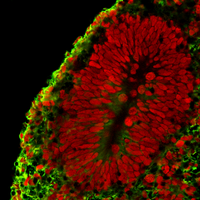Neurodevelopment
 The mammalian brain is a highly complex and spatially heterogeneous structure, which has changed significantly during the evolution of modern humans. Recent progress in stem cell biology has allowed us to model human brain development in a dish using so-called brain organoids, 3-dimensional tissue cultures deriving from stem cells. Organoids provide us with unprecedented access to study human-specific features of brain development, which are normally hidden in utero. In the research group Neurodevelopment, we use organoid models to understand how brain diseases emerge at the cellular and molecular level. To do so, we either expose organoids to adverse environmental factors or genetically modify them so they represent genetically caused neurodevelopmental disorders. Our goal is to develop prevention and treatment strategies for neurodevelopmental disorders.
The mammalian brain is a highly complex and spatially heterogeneous structure, which has changed significantly during the evolution of modern humans. Recent progress in stem cell biology has allowed us to model human brain development in a dish using so-called brain organoids, 3-dimensional tissue cultures deriving from stem cells. Organoids provide us with unprecedented access to study human-specific features of brain development, which are normally hidden in utero. In the research group Neurodevelopment, we use organoid models to understand how brain diseases emerge at the cellular and molecular level. To do so, we either expose organoids to adverse environmental factors or genetically modify them so they represent genetically caused neurodevelopmental disorders. Our goal is to develop prevention and treatment strategies for neurodevelopmental disorders.
Currently on-going projects:
PCH2cure: Revealing disease mechanisms underlying the rare neurological disorder pontocerebellar hypoplasia
Funded by Chan Zuckerberg Initiative and the Eva Luise and Horst Köhler Foundation, we are working tightly with clinicians (Prof. Hendrik Rosewich and Prof. Samuel Gröschel, University Hospital Tübingen; Dr. Wibke Janzarik, University Hospital Freiburg) and the German patient organization for PCH, PCH-Familie e.V. (Drs. Julia Matilainen and Axel Lankenau).
Enhancing organoid models
Within the Excellence Cluster 3D Matter Made to Order, we are working on improving organoid models through interdisciplinary collaborations with physicists, chemists, engineers, and material scientists.
Mechanisms behind neurotoxicity
In an interdisciplinary project with Dr. Christian Mahringer, University of Stuttgart, we are revealing processes of change induced by a pharmaceutical that disrupts brain development. This project is funded by the Heidelberg Academy of Science and Humanities.
Further details can be found at sznbio.zoo.kit.edu

